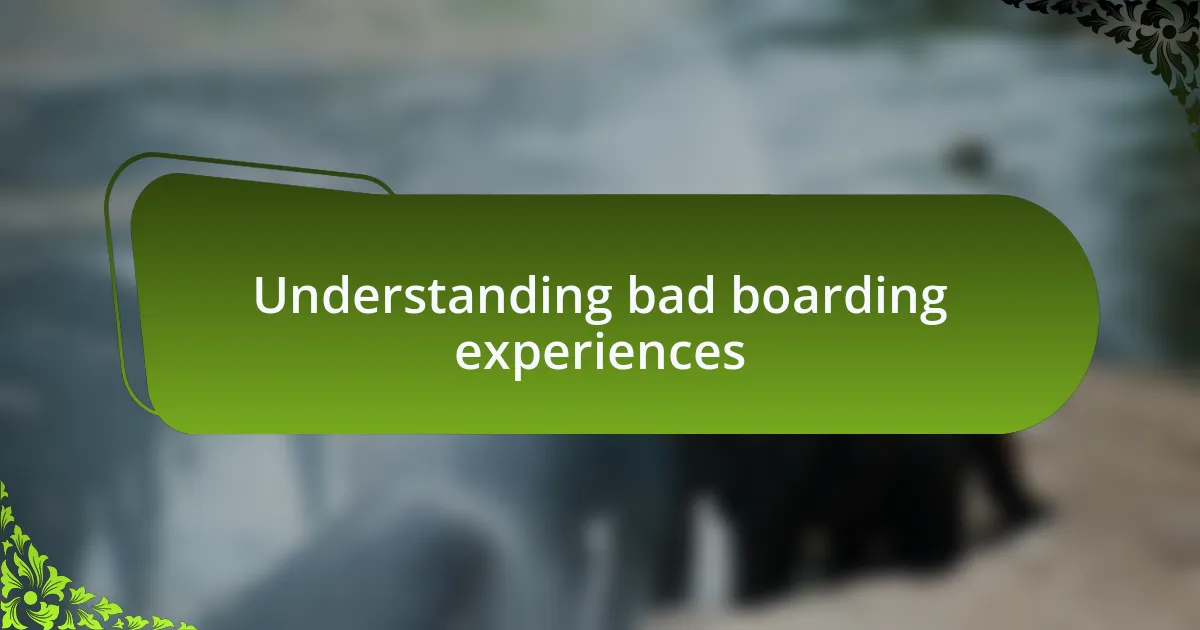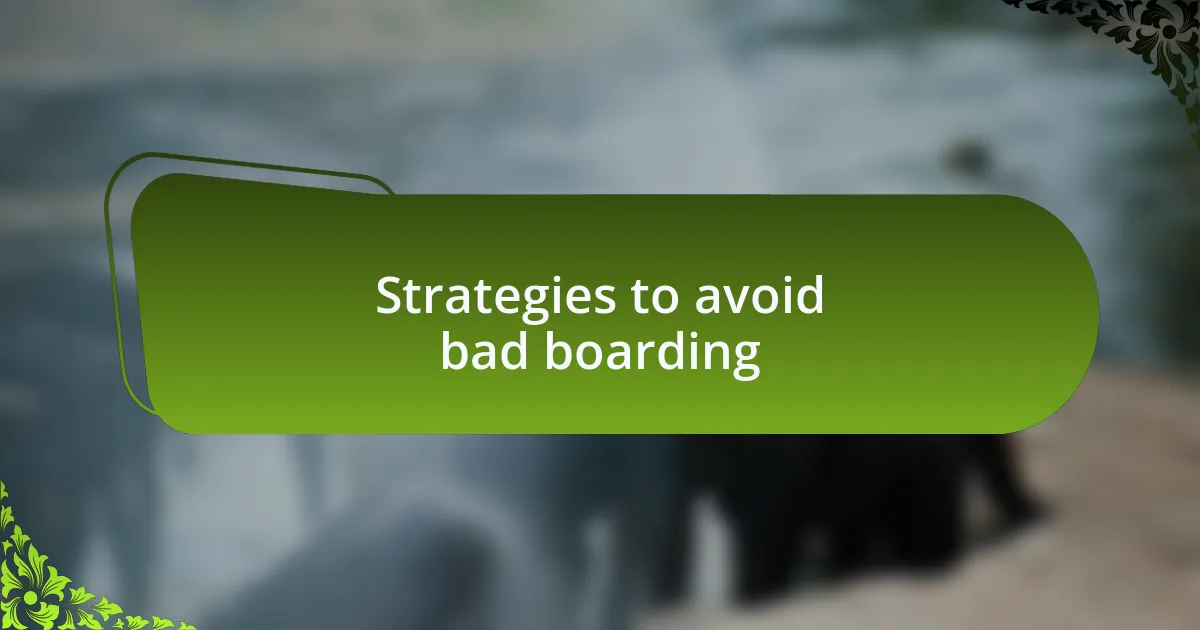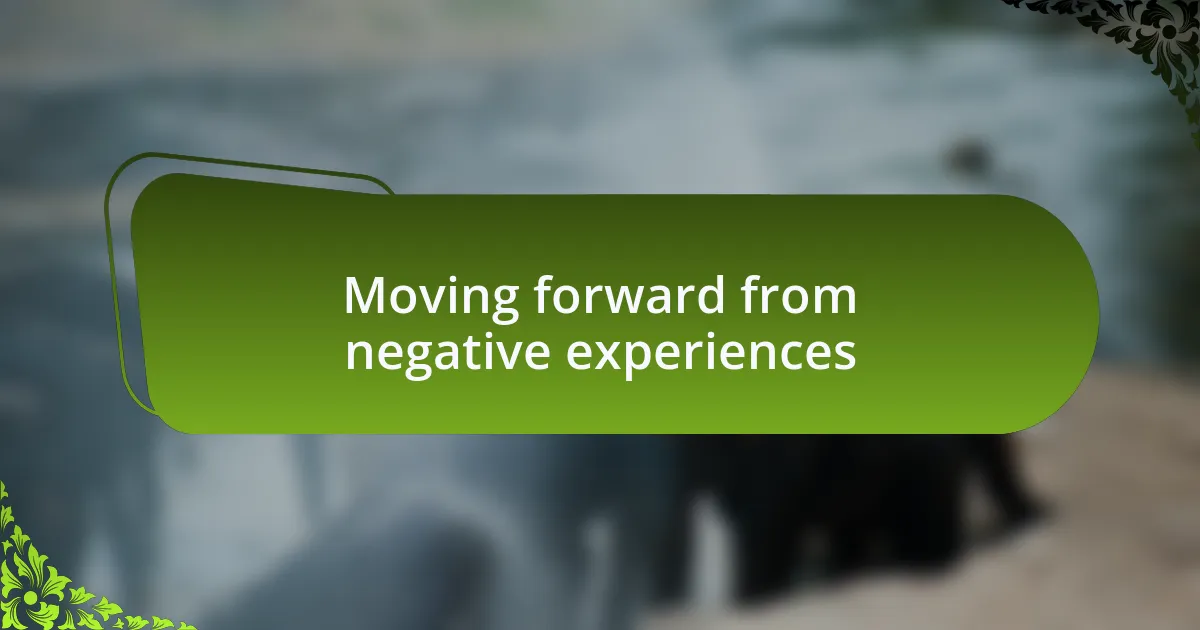Key takeaways:
- Bad boarding experiences underscore the need for compatibility between horse, owner, and facility, highlighting the emotional toll of inadequate care.
- Common issues include erratic feeding schedules, poor communication, and overcrowded barns, all of which negatively impact horse well-being.
- Establishing clear expectations, ensuring transparency about care protocols, and assessing emergency preparedness are crucial for a positive boarding experience.
- Reflecting on negative experiences and sharing insights with the equestrian community can help others avoid similar pitfalls and promote better care standards.

Understanding bad boarding experiences
Bad boarding experiences can often be a stark reminder of how important compatibility is between horse, owner, and facility. I remember a time when I moved my horse to a new barn, eager for better riding opportunities, only to discover a lack of proper care that left my horse anxious and unwell. How can a place that promises safety and support turn into a source of stress?
The emotional toll of inadequate boarding aligns closely with our bond with our horses. I once observed a friend grappling with her horse’s sudden behavioral shifts due to neglect at a supposed ‘reputable’ stable. It really made me question: how well do we truly vet our options? Experiences like these underscore the importance of thorough research and the gut feeling we sometimes ignore, despite glaring warnings.
Moreover, I’ve realized that a bad boarding experience doesn’t just affect the horse; it can strain friendships and community bonds within the equestrian world. Have you ever felt isolated when others don’t understand your concerns about a barn’s management? I certainly have, and it reinforces how crucial it is to surround ourselves with supportive peers who share our values and concerns for our horses’ well-being.

Common issues in boarding facilities
Common issues in boarding facilities often revolve around inadequate care and inconsistent routines. I recall a time when I found myself at a facility where the feed schedule was erratic, leaving my horse constantly anxious and unsure. It made me wonder: how can a barn that claims to prioritize animal welfare overlook such a fundamental aspect of care?
Another prevalent issue is poor communication between the barn staff and horse owners. I once encountered a situation where my requests for specific riding instructions were met with indifference. It felt isolating to be unheard, especially when my horse’s needs were at stake. How do we bridge the gap between expectations and reality in these settings?
Furthermore, I’ve seen firsthand the dangers of overcrowded barns. At one facility, the horses were crammed into small paddocks, resulting in increased stress and occasional injuries from fights over limited space. This experience left me reflecting on the importance of maintaining an environment that fosters not just physical safety but also emotional well-being. What could be more critical than creating a serene space for our horses to thrive?

Personal lessons from bad experiences
When reflecting on my own bad experiences with boarding facilities, I’ve learned the immense value of establishing clear expectations from the outset. I once assumed that a facility with a shiny reputation would automatically align with my horse’s needs. However, I was surprised to discover that my expectations didn’t match the reality presented. Now, I always ask detailed questions and observe the daily routines before making a commitment. How can we ensure we find a suitable match for our beloved companions?
Another significant lesson came from a lack of transparency regarding care protocols. There was a time when I was told my horse would receive daily exercise, yet I found he was often left in a stall for hours on end. This not only affected his mood but also my peace of mind. Trust is paramount in these relationships, and after that experience, I realized the importance of having open dialogues with the staff. What are the essential details we should insist on knowing to keep our horses healthy and happy?
Lastly, my encounter with poor emergency preparedness was an eye-opener. During one boarding stint, a horse fell ill, and the staff seemed unprepared to handle the situation effectively. The panic and chaos were palpable, leaving me feeling helpless. This taught me that it’s critical to assess how barns respond to crises ahead of time. What safety measures can we advocate for to ensure our horses’ well-being during unexpected situations?

Strategies to avoid bad boarding
One effective strategy to avoid bad boarding experiences is to conduct thorough facility visits, ideally unannounced. I remember visiting a barn that looked pristine during my initial tour, but a surprise drop-in a week later revealed a different story: dirty stalls and neglected equipment. Trust your instincts; if something feels off, it probably is. Have you considered how often small details can reveal larger issues?
Another approach is to connect with other boarders at the facility before making a commitment. I once chatted with a few horses’ owners who were initially enthusiastic about a barn, only to learn they were frustrated with the inconsistent feeding schedules and lack of attention during turnout. Their candid feedback saved me from a potentially poor fit. Shouldn’t we prioritize firsthand experiences when choosing a boarding facility?
Lastly, I advise taking the time to understand the facility’s care protocols through a written agreement. On one occasion, I was given verbal assurances about care routines, but a lack of documentation left me without recourse when things went awry. Clear contracts help set expectations and provide peace of mind. How can we expect our horses to thrive if we don’t have clarity in their care?

Moving forward from negative experiences
Once you’ve faced a negative boarding experience, the next step is to reflect on what went wrong. I found it helpful to write down specific instances that led to my disappointment, which not only clarified my feelings but also identified patterns to avoid in the future. Have you ever taken the time to analyze your experiences? This kind of reflection can be eye-opening and pivotal for your next steps.
Additionally, it’s crucial to communicate these experiences to others, especially those who might be considering the same facility. I remember sharing my story in an online equestrian forum, and the responses flooded in—many had similar experiences, and together we were able to warn newcomers about potential red flags. Isn’t it amazing how shared experiences can create a sense of community and support?
Lastly, embracing a mindset of growth is essential for moving forward. After a particularly disheartening situation, I chose to focus on what I could learn rather than dwell on what went wrong. This shift in perspective helped me develop a stronger resolve to seek out better environments for both me and my horse. Have you thought about how such experiences can ultimately lead to better choices in the future?